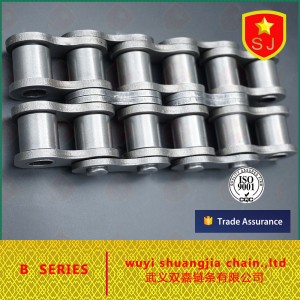The main failure modes of chain drives are as follows:
(1)
Chain plate fatigue damage: Under the repeated action of the loose edge tension and tight edge tension of the chain, after a certain number of cycles, the chain plate will undergo fatigue damage. Under normal lubrication conditions, the fatigue strength of the chain plate is the main factor that limits the load-bearing capacity of the chain drive.
(2)
Impact fatigue damage of rollers and sleeves: The meshing impact of the chain drive is first borne by the rollers and sleeves. Under repeated impacts and after a certain number of cycles, the rollers and sleeves may suffer impact fatigue damage. This failure mode mostly occurs in medium and high-speed closed chain drives.
(3)
Gluing of the pin and sleeve When the lubrication is improper or the speed is too high, the working surfaces of the pin and the sleeve will glue. Gluing limits the limit speed of the chain drive.
(4) Chain hinge wear: After the hinge is worn, the chain links become longer, which can easily cause tooth skipping or chain detachment. Open transmission, harsh environmental conditions or poor lubrication and sealing can easily cause hinge wear, thus drastically reducing the service life of the chain.
(5)
Overload breakage: This breakage often occurs in low-speed and heavy-load transmissions. Under a certain service life, starting from a failure mode, a limit power expression can be derived.
Post time: Feb-21-2024

